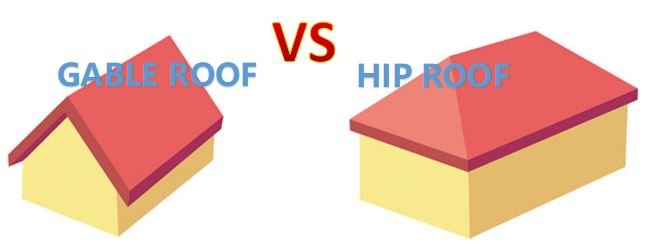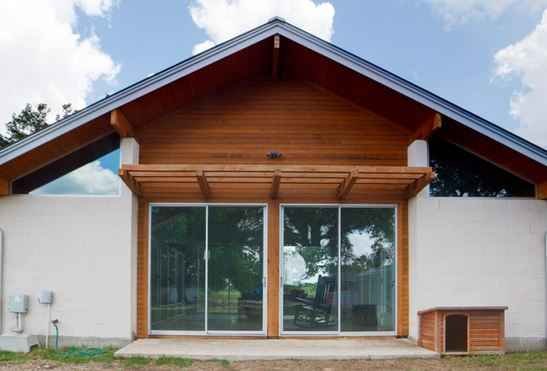There are two most popular types of roof styles that you can choose for your house: hip vs. gable roof. Each of them has its own unique characteristics. It depends on your preference to pick one or mix them as a hip and gable combination.
The hip roof is a type where every side slopes downwards to the walls, making it ideal for those seeking a more seamless design. A popular type of hip roof is the pyramid roof, where the sides meet at a single point, offering a stylish yet robust structure.

Read also: Common Roof Pitch Angles
Gable roof design
Gable roofs are usually used in some parts of the world where the climate or temperature is cold. The two sides of the roofs are placed in the highest, and horizontal edges meet to form the roof ridge. Various roof materials can be used in this type of roof, including shingles, metal, and clay tiles.

A hip roof, with its simple design and four sloping sides, can withstand high wind better than other types of roofs, making it a suitable option for areas prone to strong winds.
According to the pitch of the height of the gutters and the pitch of the roof, there are various types of this roof.
- Side gable: it is the most basic design of a gable roof. It contains sides pitched and two equal panels. Both parts of the roof meet in the middle of the building, where they meet at the ridge. You can leave the triangle section open for an open gable roof, and for the boxed gable roof, you can close it.
- Crossed gable: it is usually used in Tudor and Cape Cod styles of houses. It’s a type of gable roof where you can put together the two sides at the right angle. Both sides are perpendicular to each other. Their pitches, lengths, and heights may be the same or different from each other.
- Front gable: this design is placed at the house entrance, and you can recognize this type in Colonial-style houses. It’s also a typical design for streets in German cities in the medieval Gothic period. While in America, this type was widely used in the early 19th century.
Hip roof advantages and disadvantages
The hip roof usually has a gentle slope that houses this type of roof with no vertical sides or gables. Its shape is similar to the mansard roof, and it might have two triangular sides and two trapezoids. In rectangular design, you can plan for four faces. The center lines of the hip roof are symmetrical because of the same pitch or slope.
If you live in a region with frequent hurricanes, you’ll want to choose a hip roof. It is more stable than gables because hip roofs don’t have flat, large, and slab-sided ends that catch more wind. However, remember that you have to make the roof at least thirty-five degrees from horizontal.
The steep slope works like airplane wings, and you want to have that to anticipate hurricanes. It is more likely for the roof to uplift if you make the slopes less than 35 degrees.
Besides the advantages, you should consider the disadvantages of a hip roof because you’ll have less room inside the roof’s space. When it comes to maintenance, it’ll cause more effort because access to the roof is difficult.
Another drawback is that you’ll have trouble installing ventilation to the roof, and you might not get any natural light.
Hip and gable roof combination
You might be familiar with this type of roof if you live in countries like Denmark or Germany. It is also a typical roof for traditional timber frame buildings in South East England.
Besides, you may pick this type because you don’t know what to choose between hip vs. gable roof. You can get this type by adding an add-on to a gable roof that works well with a hip roof.
It is called half-hipped (clipped gable, Jerkin Head, or Dutch hip). It’s a perfect option for you who don’t know what some changes to the walls. The combination of hip and gable roofs makes the hipped parts stay at the top, while the gable ones are lower. You can apply some changes and attachments to both roofs to make your house look incredible without even trying hard.
Another combination you might want to pick is the Dutch gable roof. It is a type of roof where the gable part is placed at the top of the hip to give more space and give your house a more appealing aesthetic. Don’t forget to ensure you have estimated the cost of combining the two roofs.
With its amazing look, of course, it will be worth it. But if you’re not ready for costly roofs, the regular hip or gable type might also serve your needs. Don’t take too much thought in comparing hip vs. gable roofs because plenty of other parts of the house also need your consideration.


